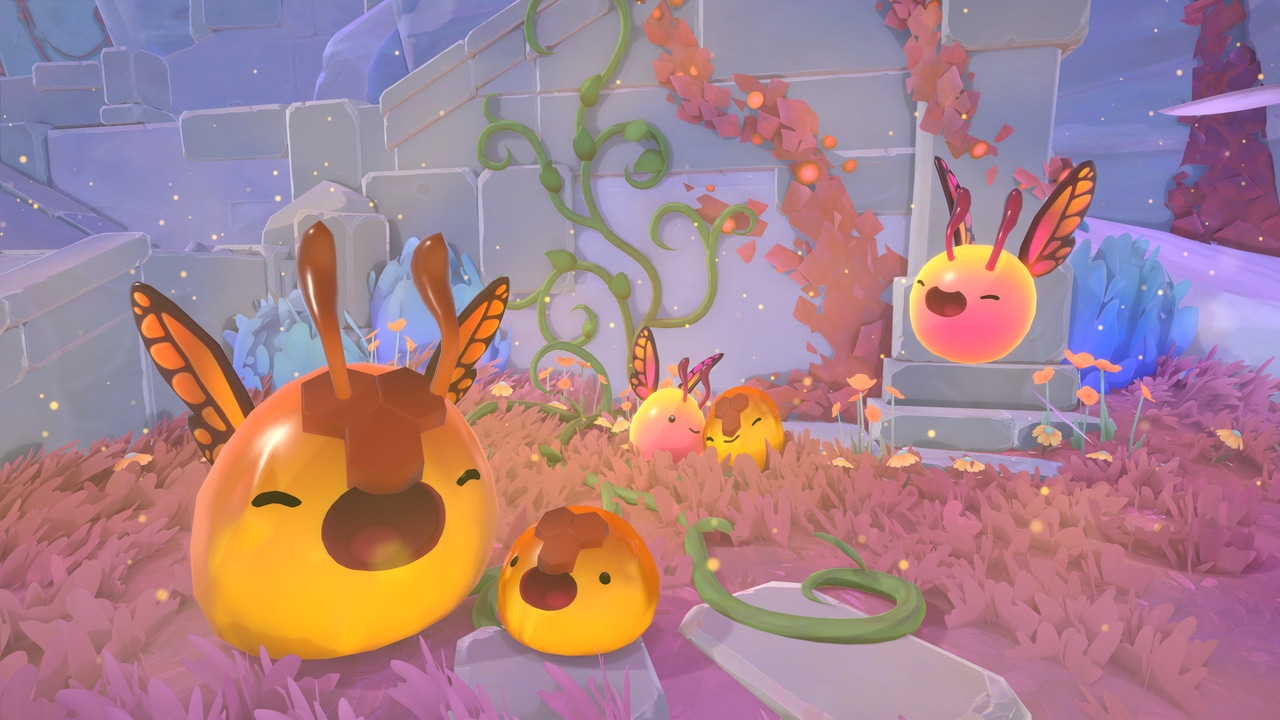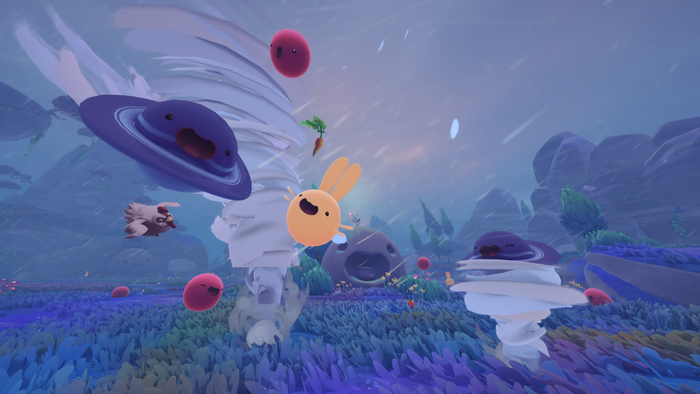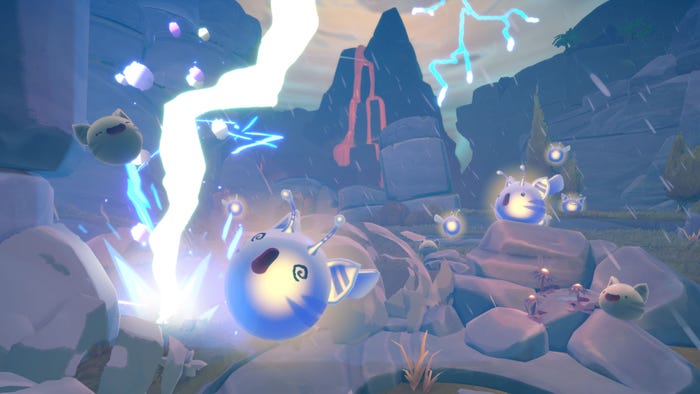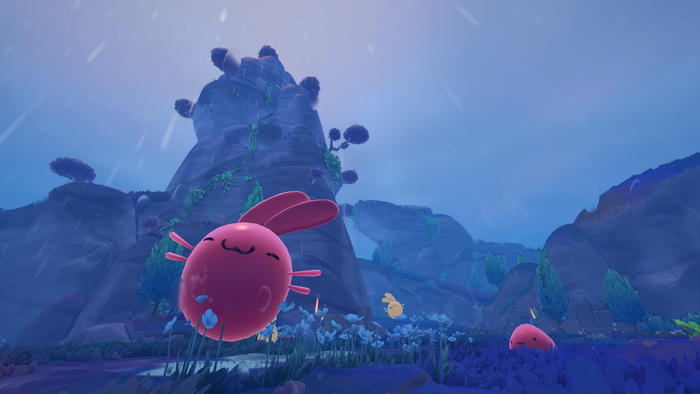Trending
Opinion: How will Project 2025 impact game developers?
The Heritage Foundation's manifesto for the possible next administration could do great harm to many, including large portions of the game development community.
At the intersection of technical and creative is the intense work that went into making these effects.

Game Developer Deep Dives are an ongoing series with the goal of shedding light on specific design, art, or technical features within a video game in order to show how seemingly simple, fundamental design decisions aren’t really that simple at all.
Earlier installments cover topics such as how indie developer Mike Sennott cultivated random elements in the branching narrative of Astronaut: The Best, how the developers of Meet Your Maker avoided crunch by adopting smart production practices, and how the team behind Dead Cells turned the game into a franchise by embracing people-first values.
In this edition, the creators of Slime Rancher 2's new weather system provide personal insights into the development process and the experiential impact they hope it will have on players.
The new weather system is a dynamic element that adds depth to the game world without compromising its core aesthetic. It introduces a layer of atmosphere beyond slime interactions, allowing players to experience the same zones in different ways depending on the weather. It provides players with more ways to immerse themselves in the game world, encompassing a range of weather elements, from pollen and wind to rain and lightning bolts.
Each team and its members had a unique role in bringing the weather system to life, and we’d like to walk you through how we collaborated to bring this experience together. By way of introduction, we are:
Dyala Kattan-Wright, senior systems designer, focused on overall balance and tuning of the system.
Tess Daniel, game engineer, was responsible for turning designs and art assets into functional elements in the game.
Norma Martinez, art lead, placed the weather in the environments and worked closely with the Tech Art team to fine-tune the visual aspects of the weather, ensuring it seamlessly integrated into the game's existing aesthetic.
What sets the weather system apart from previous updates in Slime Rancher 1 and 2 is how our teams explored various environmental changes. Experimentation helped us refine what sorts of experiences we wanted to deliver with weather, making it a perfect fit for the game's evolving world. Delivering fresh experiences within the same zones has been important in differentiating Slime Rancher 2 from its predecessor.
The weather system is designed to interact with existing systems and become more interesting when weather patterns are layered on each other. This dynamic adds depth and complexity to gameplay, offering players a wealth of emergent behaviors to discover.

Here's what the rain looks like in-game. Image provided by publisher.
Because weather added a totally new dynamic to the game that hadn’t been seen before, it brought with it new challenges, which the tech art team approached by developing some custom tooling in Unity.
First challenge: Establishing a seamless integration of the newly introduced weather elements within the Slime Rancher world.
Approach: typically, a new feature would be added into the world in different sections, focusing on one cell at a time. To streamline the set dressing process, the team worked from the largest elements to the smallest, aiming to add a purposeful weather design effect without creating chaos. By creating a custom tool in Unity, the team was able to easily place elements, such as puddles, and have the tool automatically determine the appropriate folder and zones for them, all while considering the current conditions, such as rain. This automation significantly reduced the manual and tedious aspects of the team’s work, thanks to the scripting expertise of the technical artists. The UI was straightforward, enabling the art team to control weather, puddles, streams, pollen clouds, and vines within Unity. Such custom tooling not only saved time for the art department but also benefited design, quality assurance, and engineering teams, eliminating the need to test for misplacement or loading issues.
Second challenge: Gaining insight into the visual and dynamic interactions of various weather systems when combined in different permutations (e.g., Rain + Tornadoes + Lightning, etc.).
Approach: another custom editor in Unity was created that enabled the team to activate different weather conditions at once. This feature proved to be beneficial for all departments involved in the project. Designers could assess how elements behave under various weather combinations, ensuring that too many conditions were not overwhelming. Engineers could identify any performance or functionality issues caused by heavy weather effects. Artists could fine-tune the appearance of different weather elements, such as clouds during thunderstorms or rain, to create a harmonious visual experience. This collaborative effort underscored the critical role played by the technical artists in developing custom tools that improved the efficiency and quality of the team’s game development process.
My role involves a lot of collaboration with other departments. I worked closely with Tess to define the underlying rules of the system and how to set it up in a way to be able to achieve the desired tuning and balance. Together, we aim to enhance the game's atmosphere while adhering to the game's art direction, offering players diverse experiences in familiar zones through various weather conditions.
Designing weather in Slime Rancher 2 was a unique challenge. It's about creating an emotional connection that aligns with the game's mood. We settled on six weather types, from serene rain to intense storms, and meticulously tested and iterated to ensure the desired player experience.
My passion lies in injecting a dynamic layer into the game world, providing fresh experiences as players navigate familiar landscapes under changing skies. Slime Rancher 2's weather system isn't just about gameplay; it's about evoking emotions and enhancing immersion.

A screenshot of the lightning effects. Image provided by publisher.
Developing this system was no small feat, given the challenge of translating real-world weather patterns into the gaming universe. Initially, I experimented with physical variables like pressure and temperature, but I soon realized that achieving the desired results was anything but straightforward. It was a complex puzzle to solve.
In my role, I serve as the facilitator, taking artistic objects, effects and sequences, and making them into tangible elements that seamlessly fit into the game. I'm the architect behind the tools that enable dynamic changes over time. I orchestrate how weather patterns interact with one another, developing the systems that allow Dyala to fine-tune and implement weather in a way that feels just right to players. My expertise lies in crafting intricate machinery that ensures the weather system isn't just an addition but an essential and immersive part of the Slime Rancher 2 experience.
My role is a delicate dance between creativity and technical finesse, where every visual detail matters. Collaborating closely with the tech art team, I fine-tune the visual aspects of the weather, ensuring they seamlessly integrate into the game's existing aesthetic.
Our team embarked on a journey of experimentation, from bending trees in heavy wind to crafting vivid rain effects. However, one of the most challenging aspects was portraying pollen in a way that felt truly integrated into the game's whimsical world. Striking the perfect balance between making weather stand out and have a strong presence without dominating and overwhelming a scene.
Part of the enjoyment of this project with the ability to explore the nuances of raindrops, carefully considering their size, transparency, and color. As a team, we delved into how pollen interacts with the game's day-night cycle and crafted unique lighting for each zone. Even elements like clouds required careful balancing to prevent them from overshadowing essential gameplay elements. Each element, from puddles to pollen and vines, was painstakingly placed to avoid visual clutter and seamlessly blend into the game world.
It was important for us to maintain a high level of fidelity while upholding the game's whimsical style. Challenges like achieving the right balance between transparency and color in water effects and controlling the density of raindrops to prevent visual chaos were essential in ensuring that each visual element contributed to the overall immersive experience.

A screenshot of the rain in action. Image provided by publisher.
The weather system is designed to evoke emotions, not just deliver a mechanical experience. Norma mentioned that players might find solace in peaceful rain or humor in a sudden tornado. Tess shared a personal childhood memory of seeking shelter from rain under her grandparent’s house arches, an experience she was able to relive while testing the new weather system in Slime Rancher 2. Dyala expressed the hope that players would find the weather system transformative, providing moments of emotional connection within the game's world.
Slime Rancher 2's new weather system represents a unique blend of artistry and technical innovation. Our team's dedication to creating emotionally impactful weather experiences promises to immerse players in the whimsical, ever-evolving world of slime ranching like never before. As players traverse familiar landscapes under different weather conditions, they can anticipate a fresh and engaging journey in Slime Rancher 2, so stay tuned for more details on this imminent update to come this fall.
You May Also Like